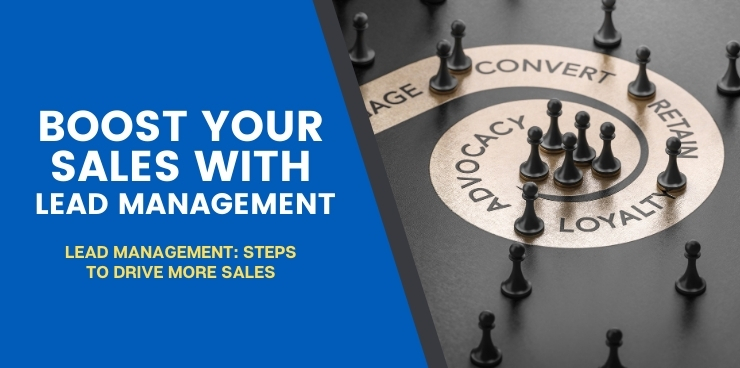Driving Sales With Lead Management
No matter what industry you’re in, if you have a product or service, you want to sell it. It’s not doing anyone any good sitting on the shelf. To make sales effectively, you need to use lead management. It should be a crucial part of your sales process.
Lead management involves directing prospects down the sales pipeline. Your marketing team attracts them. Then, your sales team closes the deal. Working together, these two groups drive your company’s success.
The right lead strategy simplifies and speeds up this process, so it’s vital to design it carefully. You will incorporate a variety of elements into your plan. Lead scoring, lead nurturing, and marketing automation will all be helpful.
What Is Lead Management?
Before you can start building a lead management strategy, you need to know what it is. In short, lead management is the process that connects marketing and sales. If you’re familiar with our work, you know how vital channel alignment is here at Selling Revolution. Lead management is a critical part of that.
Lead management is how you track, manage and analyze prospects. With the information collected, your marketing department can send the best leads to your sales team. A well-prepared lead is far more likely to make a purchase than one who hasn’t experienced management.
The first part of lead management is lead generation. Without leads, the whole process collapses. Generating leads involves identifying prospects and then nurturing your relationships with them.
That brings us to lead nurturing. Once you have a lead, you need to build and reinforce that relationship, even after you make a sale. Repeat customers can become extremely profitable.
Every part of lead management involves data collection and analysis. The more data you have on your leads, the more effectively you can operate. It’s essential to have the best software and people working with your data.
Why Do You Need Lead Management?
If you’re not already using lead management, you may wonder what the point is. You’ve made it this far without it, so why change?
To begin with, you’re probably already practicing pieces of it, even if you’re calling it something else. The basics are intuitive, and you can see them everywhere. Without meaning to, you’ve almost certainly picked some of them up.
Let’s say you run a small business. You’re the only employee, and you sell pottery.
The interest poll in your Instagram story? It’s lead management when you use it to determine which of your followers are most likely to buy from you. When you shift your social media strategy to better align with more engaged leads, that’s lead management too.
Whether you have one employee or thousands, lead management can help you.
Intentionality makes lead management more effective. It turns a guessing game into a science. With it, your business can learn and grow.
When you apply lead management, you can improve your sales tactics. You’ll save time as you get better at attracting and converting leads. From there, your bottom line will improve.
Effective Steps To Drive More Sales With Better Lead Management
The best advice is easy to follow and well-organized. That’s why we put together these six effective steps to improve your lead management strategy. Better lead management will drive more sales and your company’s success.
Determine Your Lead Management Process
Before you do anything else, you need to have a plan in place. That means defining your process in detail. Vague ideas are not enough.
Start by making a list of your goals and existing knowledge. From there, work backward. Let’s say you want to increase revenue by five percent over the next quarter. What steps do you need to take to get there?
When you outline and formalize your lead management process, you can improve your operations rapidly.
It’s not just your interactions with leads that you need a plan in place for, either. Document all of your policies. That includes how you’re going to store and manage sales and marketing data.
Are you having trouble identifying your goals? Implement the SMART strategy. Every goal you make should be specific, measurable, attainable, relevant and time-based.
Not sure how to organize the information you have? We’re going to cover customer relationship management (CRM) software later. Spreadsheets aren’t always enough to keep track of complex relationships.
Include All Stakeholders When Creating Your Demand-Generation Strategy
When you think about creating demand for a product or service, you probably think of marketing. It’s true that your marketing team is the backbone of the process, but they’re not the extent of it.
Your sales team needs to get involved too. There needs to be communication between marketing and sales. If there isn’t, leads will slip through the cracks.
Everyone needs to be on the same page. Gathering input from demand-generation stakeholders when creating your strategy ensures they are.
It’s not just marketing and salespeople that you need to talk to, though. Consult with your IT department, operations managers and others.
Interdepartmental meetings are rarely anyone’s favorite, but they allow for increased communication. Have representatives from all relevant departments involved in strategy meetings.
Consider implementing additional training relating to lead management too. Employees will get to know each other and their roles better.
Generate Buyer Personas for Relevant Leads
It’s not enough to know the demographics of your target market, although that’s a good foundation. Demographic information is helpful for making broad generalizations. It’s less useful when you’re trying to do something specific, like selling a particular product.
Maybe women in their 30s would express interest in your product. Or, maybe age and gender have nothing to do with it. That depends on your circumstances.
Instead, you should generate thorough and unique buyer personas.
It doesn’t make sense to market to individuals. The time and money trying to do so would consume makes the idea untenable.
When you focus on marketing to groups of individuals with a lot of shared characteristics, you’ll have better luck. Some characteristics to look at include:
- The needs of your prospective customers. What problems do they face? How can you solve them?
- What your prospects want and prefer, although don’t necessarily need.
- What motivates your customers to act and buy.
Don’t forget to include the basics. Budget, likes, dislikes and other general information is helpful as well.
 Create Content Aimed Toward Specific Buyer Personas
Create Content Aimed Toward Specific Buyer Personas
Once you create buyer personas, you can start marketing toward them. When you’re creating content, you need to have an audience in mind. Imagine if you didn’t. What would be the point?
Content creation without a target audience is a waste of time and money. Generalizing won’t work. You made buyer personas for a reason. Use them.
Go back and look at the needs you identified for each persona. How can your product or service meet them? Be specific.
Clearly lay out why your product or service is the solution a lead needs. The more detail you can offer, the more persuasive you will be.
Many companies profess that they are customer-oriented. Here’s your chance to test your commitment to that claim. It’s all about framing.
You’re selling a product or service, it’s true. However, you’re also providing something of value. When you create content, focus on the value, not the product.
It can be challenging to separate the idea of value from the product or service creating it. Right now, you might be thinking, “wait, aren’t they the same thing?”
Yes and no. That’s not a clear answer, but it’s the truth.
To you, they’re the same. To a lead, the connection isn’t quite so clear. That’s where content aimed at highlighting value for a specific persona comes into play. Your marketing and sales teams are there to add clarity.
Don’t be afraid to adjust the personas and your strategy as necessary. That brings us to our next step.
Watch, Listen and Adjust as Needed
Your lead management strategy isn’t set in stone. It’s a dynamic process. If it stops adapting, it loses relevance. The market is never static, so you can’t be either.
That means your work is never finished. The stakeholders identified in the second step should meet at least once a month. During this meeting, they should gauge the success of the current lead management strategy.
What’s working? What isn’t? Keep the parts that work, and replace those that don’t.
It can help to consult your current customers for this step. That might mean reaching out specifically for the purpose of gathering information. It might also mean something as simple as looking at your reviews.
No one wants to fail. A bad customer review or not quite hitting a goal can feel like a failure. Both are setbacks but don’t think about them as failures. They’re not a reason to give up.
They’re also not a reason to dig your heels in. If a strategy isn’t working, let it go. Tomorrow is a new day and a new opportunity for success. Current customers will appreciate the improvements you make. New prospects might make up their mind based on something new that you’re trying.
Every time you don’t succeed, you learn. Even if an experience or idea isn’t profitable, it has value.
 Find Technology That Works for You
Find Technology That Works for You
The final step in this process is one of the most involved. Technology is constantly changing. That makes it hard to keep up with.
This is especially true in marketing and sales. The list of potentially useful technology is a long one. Social media, search engines, CRM software—it’s inescapable. Often, it’s also overwhelming.
We have some good news on that front. Whenever an exciting new technology appears, it’s tempting to incorporate it into your process. We’re here to tell you that there’s no reason to change your strategy to better fit a piece of software.
If you have something that works for you, stick with it. So many different technologies are available. You’ll be able to find one that fits into your operations like the final piece of a puzzle. Technology should not dictate your operations. Your operations should dictate the technology you use.
However, it’s crucial not to allow yourself to stagnate, technologically or otherwise. Automation isn’t just the way of the future, it’s already here. If you’re not using it, you’re behind.
No matter how fast, skilled, and dedicated your employees are, they can’t compete with marketing automation. Invest in CRM software that does everything you need it to. Your success matters too much not to.
Conclusion
With the right combination of sales prospecting and prospect marketing, you’ve found potential buyers. You’re working on converting them. You have both your sales funnel and marketing funnel defined. They’re operating in concert.
That means you’re already starting to drive more sales with lead management. Remember the basics. Stay focused on guiding your sales leads from the top of the funnel into long-term customers.
Take advantage of automation tools, but don’t rely on them completely. It takes a human touch to convert leads too. Technology can revolutionize your business when applied correctly.
If you’re looking to drive more sales, Wizard of Sales can help. We’re dedicated to aiding you in aligning the channels of your business so success—and profits—flow.
We believe it’s essential to align your advertising efforts, salespeople and web presence. That means having compelling landing pages for your website in addition to everything else we’ve covered.
Are you looking to improve your sales strategy? We can do that. What about developing an advertising strategy? We can do that too.
Sometimes, getting an outside perspective is the best way to solve problems or generate ideas. Ryan Chute has provided solutions for thousands of businesses around the world. If you want your company to be next, book a call today. Appointments fill up quickly, so don’t wait.



 Create Content Aimed Toward Specific Buyer Personas
Create Content Aimed Toward Specific Buyer Personas Find Technology That Works for You
Find Technology That Works for You